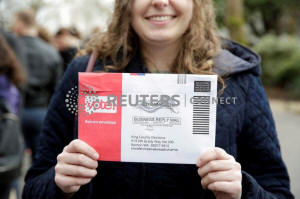Explainer: Fraud is rare in U.S. mail-in voting. Here are the methods
that prevent it
 Send a link to a friend
Send a link to a friend
 [July 08, 2020]
By Andy Sullivan [July 08, 2020]
By Andy Sullivan
WASHINGTON (Reuters) - With the number of
Americans voting by mail on Nov. 3 expected to nearly double due to
COVID-19, election experts see little reason to expect an increase in
ballot fraud, despite President Donald Trump's repeated claims.
Voting by mail is not new in the United States -- nearly 1 in 4 voters
cast 2016 presidential ballots that way. Routine methods and the
decentralized nature of U.S. elections make it very hard to interfere
with mailed ballots, experts say.
While mail balloting has its drawbacks, it can help minimize the long
lines, faulty voting machines and COVID-19-induced staffing shortages
that have plagued some elections this year.
HOW SECURE IS IT?
Election experts say it would be nearly impossible for foreign actors to
disrupt an election by mailing out fake ballots, a scenario floated by
Attorney General William Barr.

For one thing, voters won't just be selecting a president: They might be
choosing candidates for city council, school board and weighing in on
ballot initiatives. That can require hundreds of different ballot
designs in a single county and the United States has more than 3,000
counties.
Ballots aren't counted if they aren't printed on the proper type of
paper and don't include specific technical markings.
States also require voters to sign the outside of their envelope, which
they match to a signature on file.
Some 29 states and the District of Columbia allow voters to track their
ballots to ensure they are received, according to the National
Conference of State Legislatures. Fourteen states and D.C. also allow
voters to return their ballots by hand if they don't trust the mail.
Those envelopes are typically opened by a different group of workers
than those who scan the ballots. Outside observers are allowed to
monitor the process to ensure voter privacy.
IS FRAUD A PROBLEM?
As with other forms of voting, documented cases of mail-ballot fraud are
extremely rare.
The conservative Heritage Foundation, which has warned of the risks of
mail voting, found 14 cases of attempted mail fraud out of roughly 15.5
million ballots cast in Oregon since that state started conducting
elections by mail in 1998.
The most prominent cases of mail fraud have involved campaigns, not
voters. North Carolina invalidated the results of a 2018 congressional
election after state officials found that a Republican campaign
operative had orchestrated a ballot fraud scheme.
[to top of second column]
|

Lexi Menth of Seattle holds up her vote-by-mail ballot as supporters
line up at a rally for U.S. Democratic 2020 presidential candidate
Senator Elizabeth Warren at the Seattle Center Armory in Seattle,
Washington, U.S. February 22, 2020. REUTERS/Jason Redmond

Experts say those scenarios can be minimized by nixing requirements
-- currently in place in 11 states -- which instruct voters to get
at least one witness to sign their return envelopes.
"All of these policies remove the need to hand over your ballot to
someone you don't know," said Tammy Patrick, a former election
official in Maricopa County, Arizona.
DOES IT HELP TURNOUT?
Turnout rates tend to be higher in states that conduct elections by
mail. A Stanford University study found that participation increased
by roughly 2 percentage points in three states that rolled out
universal voting by mail from 1996 to 2018. It had no effect on
partisan outcome and did not appear to give an advantage to any
particular racial, economic or age group.
In Colorado, 77% of voting age citizens cast ballots in the 2016
presidential election, the highest figure in the country, according
to the U.S. Election Assistance Commission. In Oregon, that figure
was 72% and in Washington it was 68%, well above the national rate
of 63%.
ARE THERE BARRIERS?
Like any other voting method, mail balloting has its drawbacks.
States rejected 1% of returned ballots in 2016 for arriving too
late, missing signatures or other problems, according to EAC figures
-- though that figure was as high as 5% in some states. It can be
more difficult to fix errors on mail ballots than on those cast in
person, experts say.

Mail ballots can pose additional barriers to those who don't speak
English or have disabilities, and delivery can be problematic on
Native American reservations, where residents sometimes don't have
street addresses.
In California, which started transitioning to mail ballots in 2018,
Black and Hispanic voters were twice as likely to cast their ballots
in person, according to David Becker, head of the Center for
Election Innovation and Research.
(Reporting by Andy Sullivan; Editing by Scott Malone and Aurora
Ellis)
[© 2020 Thomson Reuters. All rights
reserved.] Copyright 2020 Reuters. All rights reserved. This material may not be published,
broadcast, rewritten or redistributed.
Thompson Reuters is solely responsible for this content. |